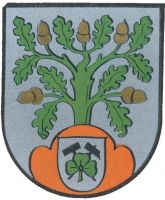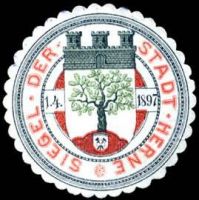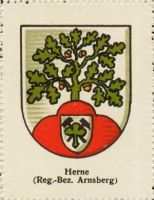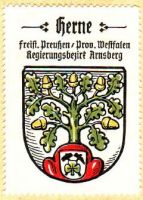Herne (Ruhr): Difference between revisions
Knorrepoes (talk | contribs) m (Text replacement - ".jpg|center]] <br/>Seal from around 1900" to ".jpg|center|Seal of {{PAGENAME}}]] <br/>Seal from around 1900") |
Knorrepoes (talk | contribs) No edit summary |
||
| (32 intermediate revisions by the same user not shown) | |||
| Line 1: | Line 1: | ||
{{ | {| class="wikitable" | ||
''' | |- style="vertical-align:top;" | ||
|[[File:Herne2.jpg|center|350 px|alt=Wappen von {{PAGENAME}}/Arms (crest) of {{PAGENAME}}]] | |||
| | |||
<center>''' {{uc:{{PAGENAME}}}} '''</center><br> | |||
'''Country''' : Germany [[File:germany.jpg|60 px|right]]<br><br><br><br> | |||
'''State''' : [[Nordrhein-Westfalen]][[File:nordrhei.jpg|60 px|right]]<br><br><br><br> | |||
'''District (Kreis)''' : Urban District (Stadtkreis)<br> | |||
'''Additions''':<br> | |||
* 1908 Baukau | |||
* 1908 Horsthausen | |||
* 1975 [[Wanne-Eickel]] | |||
** 1926 Wanne | |||
*** 1906 Crange | |||
** 1926 Eickel | |||
*** 1910 Holsterhausen | |||
** 1926 Röhlinghausen | |||
{{#display_map:51.5382, 7.2197|width=250|height=250|zoom=7}} | |||
|} | |||
{| class="wikitable" | |||
|+Official blazon | |||
|- | |||
|'''German''' | |||
| | |||
*(1900/1937) In Silber auf einem mit einem silbernen Schild belegten roten Dreiberg, darin schräg gekreuzt und überdeckt von einem grünen Kleeblatt schwarzer Schlägel und schwarzes Eisen, eine grüne zehnblättrige Eiche mit fünf goldenen Eicheln. | |||
*(1975) In Gold ein schwarzes springendes Pferd, links darüber schwarze, ins Kreuz gestellte Schlägel und Eisen. | |||
|- | |||
|'''English''' | |||
| blazon wanted | |||
|} | |||
==== | ===Origin/meaning=== | ||
Herne was an unimportant village until the mining and industry started to develop in the 19th century. The village received city rights in 1897 and in July 30, 1900 the arms were granted by King Wilhelm II of Prussia. No arms or seals are known for Herne prior to 1900. In 1900 the arms were topped by a mural crown, which was officially abandoned on November 30, 1937, when new arms were granted. The current arms were granted on January 1st, 1975. The arms combine the horse of Wanne-Eickel with the miner's tools from the older arms. | |||
<gallery widths=250px heights=200px perrow=0> | |||
File:herne2.gif|alt=Wappen von Herne/Arms (crest) of Herne|The arms from 1900 | |||
File:herne.jpg|alt=Wappen von Herne/Arms (crest) of Herne|The arms from 1937 | |||
</gallery> | |||
The tree in the old arms is described as the tree of Westfalen, the area to which the city belongs. The meaning of the tree, however, is unknown. Westfalen uses a horse in its arms, not a tree. | |||
The small hill in the base of the arms is canting, Herne is supposedly derived from Hügel (hill).<br/> | |||
The small shield in the base shows the miner's tools, obvious symbols for (at the time) a mining town. The trefoil is actually taken from the national symbol of Ireland. The trefoil, or shamrock in Irish-English, was taken as a canting symbol for the oldest mine, the Shamrock mine. The Shamrock mine was founded by the Irish coal mine pioneer William Thomas Mulvany. He also founded the coal mine Hibernia (Latin for „Ireland“) in Gelsenkirchen and „Erin“ (Irish goddess) in Castrop-Rauxel. | |||
The | ===Image gallery=== | ||
The | <gallery widths=250px heights=200px perrow=0> | ||
File:hernez1.jpg|alt=Wappen von Herne/Arms (crest) of Herne|Seal from around 1900 | |||
File:1119b.wsa.jpg|alt=Wappen von Herne/Arms (crest) of Herne|The arms in an [[Wappen-Sammlung Series 2 Cities and regions|album]] from around 1905 | |||
File:herne.sc.jpg|The arms in an [[Schuberts Album deutscher Staaten und Städtewappen|album]] from around 1910 | |||
File:herne.hagd.jpg|alt=Wappen von Herne/Arms (crest) of Herne|The arms by [[Otto Hupp|Hupp]] in the [[Kaffee Hag albums]] +/- 1925 | |||
File:3085.aba.jpg|alt=Wappen von Herne/Arms (crest) of Herne|The arms in the [[Abadie]] albums | |||
File:herne.slz.jpg|The arms in the [[Deutsche Städtewappen - Saarlautener Zigarettenfabriken]] album from 1936 | |||
File:130.kos.jpg|The arms in an [[Kosmos Deutsche Stadtwappen aus West und Ost|album]] from around 1950 | |||
File:herne.pan.jpg|The arms in an [[Panorama Bilderdienst|album]] from 1968 | |||
</gallery> | |||
[[Civic Heraldry Literature - Germany|'''Literature''']]: Stadler, 1964-1971; new images taken from <a href=http://www.herne.de/stadt/stadtwappen.html-ssi>here]] | |||
{{de}} | |||
{{media}} | {{media}} | ||
[[Category:German Municipalities H]] | [[Category:German Municipalities H]] | ||
Latest revision as of 07:44, 17 August 2024
|
Country : Germany State : Nordrhein-Westfalen District (Kreis) : Urban District (Stadtkreis)
|
| German |
|
| English | blazon wanted |
Origin/meaning
Herne was an unimportant village until the mining and industry started to develop in the 19th century. The village received city rights in 1897 and in July 30, 1900 the arms were granted by King Wilhelm II of Prussia. No arms or seals are known for Herne prior to 1900. In 1900 the arms were topped by a mural crown, which was officially abandoned on November 30, 1937, when new arms were granted. The current arms were granted on January 1st, 1975. The arms combine the horse of Wanne-Eickel with the miner's tools from the older arms.
The tree in the old arms is described as the tree of Westfalen, the area to which the city belongs. The meaning of the tree, however, is unknown. Westfalen uses a horse in its arms, not a tree.
The small hill in the base of the arms is canting, Herne is supposedly derived from Hügel (hill).
The small shield in the base shows the miner's tools, obvious symbols for (at the time) a mining town. The trefoil is actually taken from the national symbol of Ireland. The trefoil, or shamrock in Irish-English, was taken as a canting symbol for the oldest mine, the Shamrock mine. The Shamrock mine was founded by the Irish coal mine pioneer William Thomas Mulvany. He also founded the coal mine Hibernia (Latin for „Ireland“) in Gelsenkirchen and „Erin“ (Irish goddess) in Castrop-Rauxel.
Image gallery
The arms in an album from around 1905
The arms in an album from around 1910
The arms by Hupp in the Kaffee Hag albums +/- 1925
The arms in the Abadie albums
The arms in the Deutsche Städtewappen - Saarlautener Zigarettenfabriken album from 1936
The arms in an album from around 1950
The arms in an album from 1968
Literature: Stadler, 1964-1971; new images taken from <a href=http://www.herne.de/stadt/stadtwappen.html-ssi>here]]
This page is part of the German heraldry portal Deutsche Wappensammlung |
Heraldry of the World |
|
German heraldry:
|
Selected collector's items from Germany:
|
Contact and Support
Partners:
Your logo here ?
Contact us
© since 1995, Heraldry of the World, Ralf Hartemink 
Index of the site
























